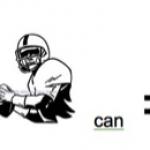Will the NFL Survive the New Science of Brain Damage?

The most important breaking story in sports is not something you’ll see on ESPN or the assorted copycat networks. It is a story that affects multiple sports, but most primarily football. The NFL is in the midst of a free-agent frenzy, signing players to $100 million deals to the breathless panting of sports media carnival barkers—but new developments in the science of diagnosing brain damage threatens not only those nine-figure contracts but the entire multibillion-dollar football industry as well.
Until now, diagnosing the remorseless brain disease chronic traumatic encephalopathy (CTE) could only be done after death. Former NFL players have died (many by shooting themselves in the chest or hanging themselves, to preserve their skulls) and their families have donated their brains to science so CTE could be diagnosed postmortem.
These studies have been damning, yet critics have always said that the high rate of CTE found in these players’ brains is flawed since they were donated from people who have “shown signs” of CTE. In other words, if a former player has symptoms such as early onset Alzheimer’s, memory loss, suicidal ideation, or other forms of what is, in layman’s terms, “brain damage,” then their families are more likely to donate their brains to these studies.
This explanation has also allowed NFL executives, franchise owners, players, and fans to put CTE out of their thoughts. Meanwhile, the league has adopted cosmetic changes to the rules and the equipment to market the illusion that it is safer (or even safe at all) to play tackle football.
Yet science is not on the NFL’s side, and the more our ability to detect CTE in the living improves, the more greater the existential threat becomes to the future of the almighty religion that is football. The latest scientific news is that over two dozen scientists, funded by the National Institute of Neurological Disorders and Stroke, have produced the first consensus criteria to diagnose CTE among the living. This paper, which went public on Monday, is a step toward a “biomarker” that can definitively say whether a living person is suffering from CTE.
Robert Stern, director of clinical research at Boston University’s CTE Center and one of the paper’s authors, said upon releasing the study, “Although I wish I could say it’s a game-changer right now, it’s a game-changer for the future. We’re really not at the point of being able to diagnose CTE during life yet. We’re getting much closer, and this new paper is an important step forward.”
This study, while not perfectly able to “diagnose CTE during life,” will help identify CTE’s unique symptoms that result from head injuries, determine its prevalence among athletes, and allow medical professionals to better determine the risks involved from suffering concussions. It’s a massive step forward.
In the near future, athletes of any age will be able to be diagnosed. Currently the great unknown for CTE is when it develops: youth football? High school? College? The pros? We know from youth suicide cases that CTE can be not only detectable at an early age but also shockingly widespread throughout the brain. That was the condition of New England Patriot and murderer Aaron Hernandez, who was found to have a terrible case of CTE following his jailhouse suicide by hanging.
I reached out to Dr. Chris Nowinski, cofounder and CEO of the Concussion Legacy Foundation, a nonprofit organization leading the fight against concussions and CTE. Several lifetimes ago, Nowinski was a professional wrestler who suffered from concussions. He said, “As we inch closer to definitively diagnosing CTE in living people, we should anticipate many difficult conversations. For example, CTE in athletes is preventable, and we know the onset of the disease can occur in minors. If we diagnose a 16-year-old football player with CTE, should youth football continue? Adult athletes may soon learn they have CTE while they are still playing. Will they retire? It’s difficult to predict how individuals will respond when we can finally diagnose the disease in life, but we should begin to prepare for that day.”
Nowinski really hits the nail on the head (pardon the expression). CTE is a degenerative disease that worsens with repeated impact and abuse to the brain. If youth, high school, or college football players can be diagnosed with it, it puts the NFL’s entire talent pipeline in a great deal of jeopardy—not to mention its future financial prospects.
The days of plausible deniability—by the NFL, by players, and by fans—will be coming to a screeching halt in the next several years. The league’s plans for dealing with that inevitability remain an unknown. One thing is certain: slogans like “Football is family” and “Moms for football” athletic clinics are no longer going to cut it. We are officially past the point of CTE’s being a subject of debate. The new debate will be over football itself.
Dave Zirin is the sports editor of The Nation and the author of Game Over: How Politics Has Turned the Sports World Upside Down. TWITTER
Copyright c 2021 The Nation. Reprinted with permission. May not be reprinted without permission. Distributed by PARS International Corp.
Please support progressive journalism. Get a digital subscription to The Nation for just $12.00!
